Xiaotian Song
LAS: Loss-less ANN-SNN Conversion for Fully Spike-Driven Large Language Models
May 14, 2025Abstract:Spiking Large Language Models (LLMs) have emerged as an energy-efficient alternative to conventional LLMs through their event-driven computation. To effectively obtain spiking LLMs, researchers develop different ANN-to-SNN conversion methods by leveraging pre-trained ANN parameters while inheriting the energy efficiency of SNN. However, existing conversion methods struggle with extreme activation outliers and incompatible nonlinear operations of ANN-based LLMs. To address this, we propose a loss-less ANN-SNN conversion for fully spike-driven LLMs, termed LAS. Specifically, LAS introduces two novel neurons to convert the activation outlier and nonlinear operation of ANN-based LLMs. Moreover, LAS tailors the spike-equivalent Transformer components for spiking LLMs, which can ensure full spiking conversion without any loss of performance. Experimental results on six language models and two vision-language models demonstrate that LAS achieves loss-less conversion. Notably, on OPT-66B, LAS even improves the accuracy of 2\% on the WSC task. In addition, the parameter and ablation studies further verify the effectiveness of LAS. The source code is available at https://github.com/lc783/LAS
FAS: Fast ANN-SNN Conversion for Spiking Large Language Models
Feb 06, 2025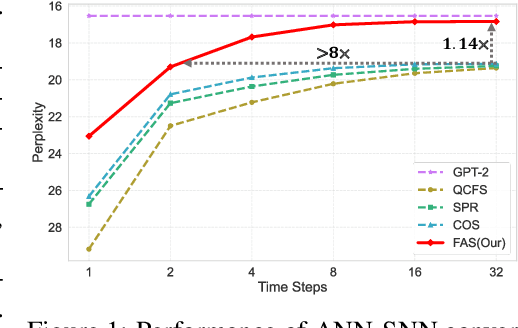
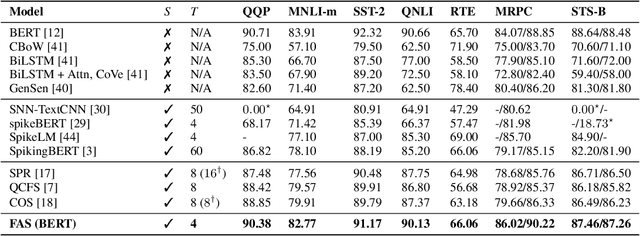
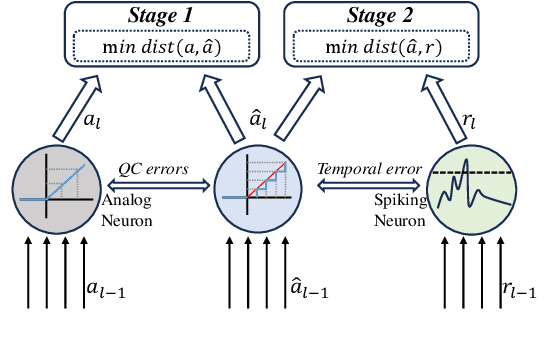

Abstract:Spiking Large Language Models have been shown as a good alternative to LLMs in various scenarios. Existing methods for creating Spiking LLMs, i.e., direct training and ANN-SNN conversion, often suffer from performance degradation and relatively high computational costs. To address these issues, we propose a novel Fast ANN-SNN conversion strategy (FAS) that transforms LLMs into spiking LLMs in two stages. The first stage employs a full-parameter fine-tuning of pre-trained models, so it does not need any direct training from scratch. The second stage introduces a coarse-to-fine calibration method to reduce conversion errors and improve accuracy. Our experiments on both language and vision-language tasks across four different scales of LLMs demonstrate that FAS can achieve state-of-the-art performance yet with significantly reduced inference latency and computational costs. For example, FAS only takes 8 timesteps to achieve an accuracy of 3% higher than that of the OPT-7B model, while reducing energy consumption by 96.63%.
Revisiting Neural Networks for Continual Learning: An Architectural Perspective
Apr 28, 2024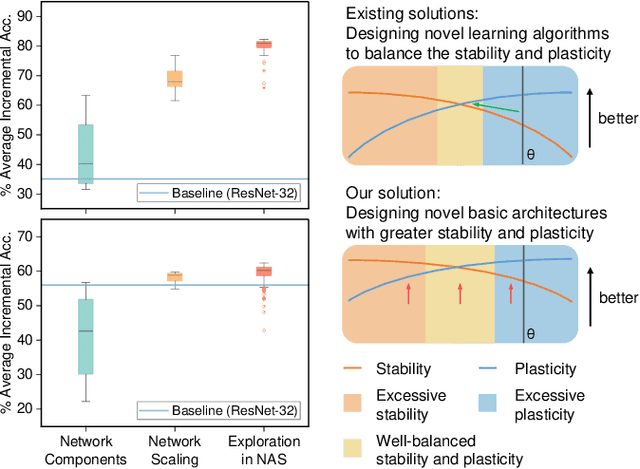
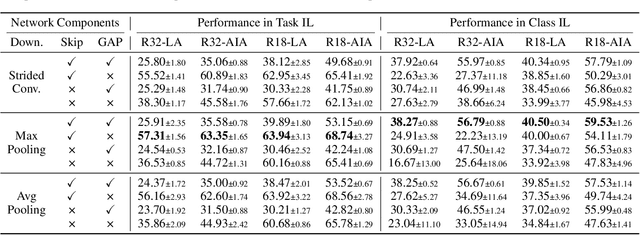
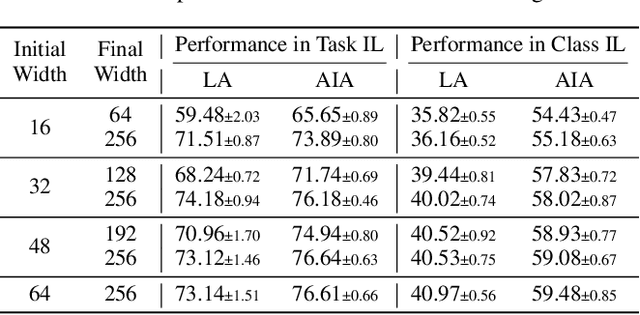
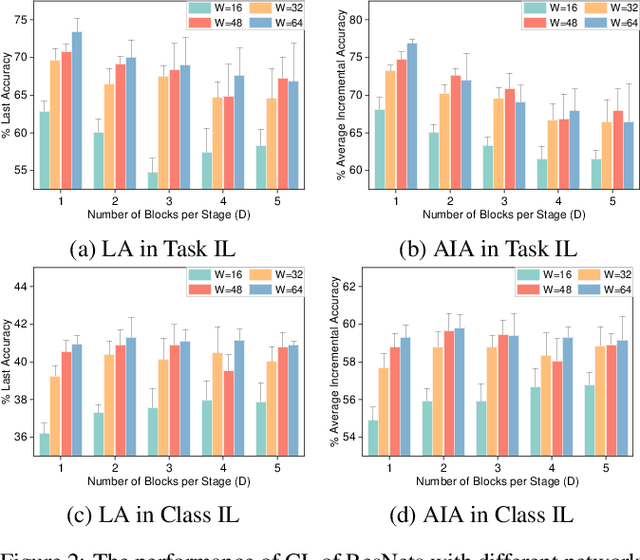
Abstract:Efforts to overcome catastrophic forgetting have primarily centered around developing more effective Continual Learning (CL) methods. In contrast, less attention was devoted to analyzing the role of network architecture design (e.g., network depth, width, and components) in contributing to CL. This paper seeks to bridge this gap between network architecture design and CL, and to present a holistic study on the impact of network architectures on CL. This work considers architecture design at the network scaling level, i.e., width and depth, and also at the network components, i.e., skip connections, global pooling layers, and down-sampling. In both cases, we first derive insights through systematically exploring how architectural designs affect CL. Then, grounded in these insights, we craft a specialized search space for CL and further propose a simple yet effective ArchCraft method to steer a CL-friendly architecture, namely, this method recrafts AlexNet/ResNet into AlexAC/ResAC. Experimental validation across various CL settings and scenarios demonstrates that improved architectures are parameter-efficient, achieving state-of-the-art performance of CL while being 86%, 61%, and 97% more compact in terms of parameters than the naive CL architecture in Task IL and Class IL. Code is available at https://github.com/byyx666/ArchCraft.
Differentiable Genetic Programming for High-dimensional Symbolic Regression
Apr 18, 2023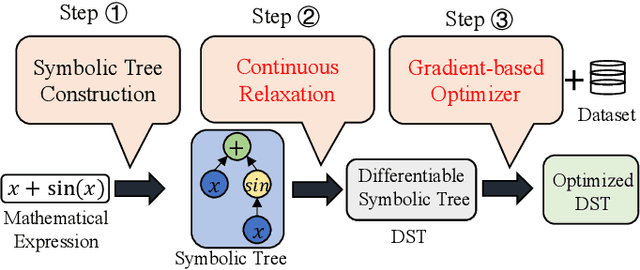



Abstract:Symbolic regression (SR) is the process of discovering hidden relationships from data with mathematical expressions, which is considered an effective way to reach interpretable machine learning (ML). Genetic programming (GP) has been the dominator in solving SR problems. However, as the scale of SR problems increases, GP often poorly demonstrates and cannot effectively address the real-world high-dimensional problems. This limitation is mainly caused by the stochastic evolutionary nature of traditional GP in constructing the trees. In this paper, we propose a differentiable approach named DGP to construct GP trees towards high-dimensional SR for the first time. Specifically, a new data structure called differentiable symbolic tree is proposed to relax the discrete structure to be continuous, thus a gradient-based optimizer can be presented for the efficient optimization. In addition, a sampling method is proposed to eliminate the discrepancy caused by the above relaxation for valid symbolic expressions. Furthermore, a diversification mechanism is introduced to promote the optimizer escaping from local optima for globally better solutions. With these designs, the proposed DGP method can efficiently search for the GP trees with higher performance, thus being capable of dealing with high-dimensional SR. To demonstrate the effectiveness of DGP, we conducted various experiments against the state of the arts based on both GP and deep neural networks. The experiment results reveal that DGP can outperform these chosen peer competitors on high-dimensional regression benchmarks with dimensions varying from tens to thousands. In addition, on the synthetic SR problems, the proposed DGP method can also achieve the best recovery rate even with different noisy levels. It is believed this work can facilitate SR being a powerful alternative to interpretable ML for a broader range of real-world problems.
Efficient Evaluation Methods for Neural Architecture Search: A Survey
Jan 14, 2023Abstract:Neural Architecture Search (NAS) has received increasing attention because of its exceptional merits in automating the design of Deep Neural Network (DNN) architectures. However, the performance evaluation process, as a key part of NAS, often requires training a large number of DNNs. This inevitably causes NAS computationally expensive. In past years, many Efficient Evaluation Methods (EEMs) have been proposed to address this critical issue. In this paper, we comprehensively survey these EEMs published up to date, and provide a detailed analysis to motivate the further development of this research direction. Specifically, we divide the existing EEMs into four categories based on the number of DNNs trained for constructing these EEMs. The categorization can reflect the degree of efficiency in principle, which can in turn help quickly grasp the methodological features. In surveying each category, we further discuss the design principles and analyze the strength and weaknesses to clarify the landscape of existing EEMs, thus making easily understanding the research trends of EEMs. Furthermore, we also discuss the current challenges and issues to identify future research directions in this emerging topic. To the best of our knowledge, this is the first work that extensively and systematically surveys the EEMs of NAS.
 Add to Chrome
Add to Chrome Add to Firefox
Add to Firefox Add to Edge
Add to Edge